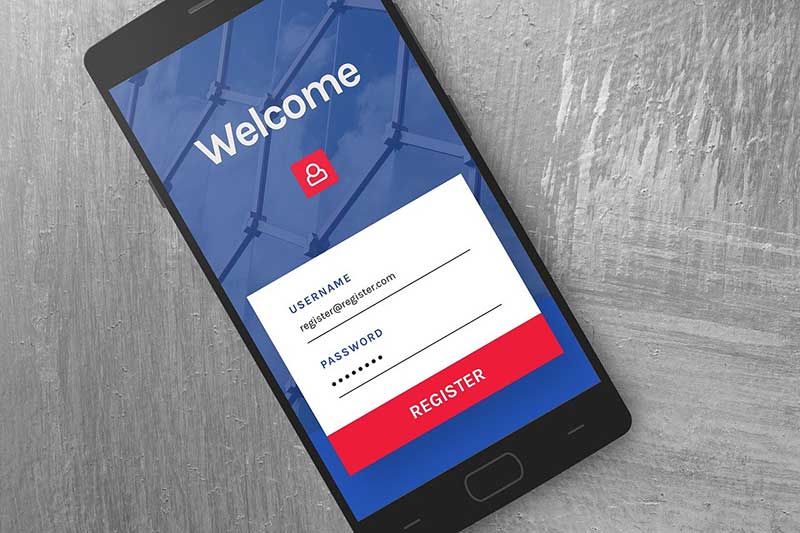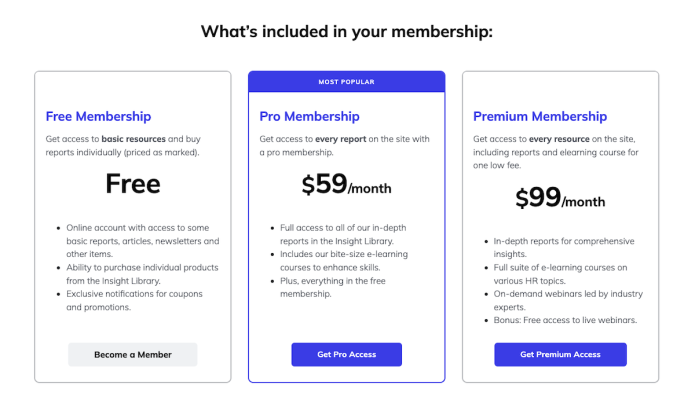
The truth is there are many ways to monetize your website, and they can all be successful if you’re willing to invest the time and energy to do them correctly. Here is a rundown of the smartest strategies to monetize a website as we approach 2023.
#1 Membership Website Model

Starting a subscription-based business tops our list of strategies to monetize your website, as it is one of the simplest and fastest ways to turn your online presence into a money-making enterprise. Creating a membership website does require a bit of planning and we have some resources you can check out to get some detailed advice on this. Generally speaking though, the primary steps to creating a membership website are as follows:
a. Know Your Audience. Who are you selling to? You must be intimately familiar with your potential buyer, what his or her problem is, and how you can solve that problem. Really get detailed about your ideal client profile with demographic information (where do they live? What age and income level re they?), behaviour information (what do they like to do? What kind of jobs do they typically work at?), and their pain points (What is the ongoing, painful problem they have?). Armed with this information, you are now ready to offer a solution to that painful problem.
b. Prepare Your Offer. What exactly do you have that can alleviate their discomfort? Picture a typical audience member in your mind, whether it’s a work at home entrepreneur, a corporate executive, male or female of a typical age for your audience. How do you envision them using your solution? Describe the solution, how easy it is to use, the features and benefits of it. By the way, there is an important distinction to be made here between features and benefits. A feature is something like Community Access, while the benefit of that feature is the ability to trade stories and get real-time encouragement. You may think the benefits of your features are obvious, but you really must spell them out.
c. Plan Your Delivery Method. How exactly are you going to package this offer and present it for sale to your potential buyers? Let’s say you’re planning to sell a monthly membership providing access to a constantly updated library of videos on keeping fit while working from home. You need to determine how much you want to charge, which videos you will package into a group to be sold for how much, how many membership levels you want to have, and whether to offer perks such as a free trial or access to a course with the subscription plan.
#2 Course Membership Model
In the SubHub platform, you can offer courses as well as membership content, so this is not an either/or situation. In fact, as mentioned, you can also offer a course as part of a subscription to membership content. Courses are a fantastic way to delivery your content because you can drip the content or have all the lessons available at the same time, effectively creating an evergreen course that doesn’t require much, if any, of your person input. If you prefer the more personal approach, you can also offer live courses through Zoom, or you can create a hybrid course where you offer a set of recorded videos, supplemented by office hours for consultations with you, or a discussion board or forum where you can answer questions.
#3 E-commerce Products

Most website frameworks or content management systems provide a free or low cost access to an e-commerce store that you can configure and start selling from with a minimum of configuration. Woocommerce for WordPress, Squarespace, Wix, Kajabi and SubHub all offer a way to sell merchandise. SubHub’s store framework also allows the sale of digital products with discounts for members, and pay per view options to sell one-off access to individual pages on your membership website.
#4 Virtual Events

Whether it’s a one-off presentation, group class or a 3-day intensive retreat, selling tickets to events online can be a perfect way to monetize your website. Many entrepreneurs make the mistake of thinking that they don’t have enough to offer an audience to generate interest in an event, or that they are’t well-known enough. First of all, remember why your followers are following you! It’s never just what you offer that interests them, it’s you too — your personality, your expertise, your willingness to share. But if that train of thought doesn’t convince you, there is another alternative: a summit.
A summit allows you to take a back seat while still hosting the event. You will be the moderator of an event featuring experts in fields related to, but not competing with, your area of expertise. You can sell any kind of event ticket through an e-commerce framework, or you can opt for a more event-specialized solution like Eventbrite. Keep in mind that many of the event software solutions out there will take a percentage of your ticket sales as payment.
#5 Speaking Engagements

Technically, this service is provided off-line, but you can certainly sell tickets and registrations to your speaking engagements online, thereby monetizing your website. Being a keynote speaker at events can be very lucrative, depending on your niche. Your website can also contain press information and a speaker's one-sheet containing your bio and a list of topics that you normally speak on. This helps prospective event managers decide if you might be a good fit for their event. Include a contact form or way to book a call so you can start the conversation. There are plenty of sites advising how to become an effective keynote speaker. Here is just one: https://keynotespeakers.info/become/
#6 Affiliate Marketing
Affiliate marketing works 2 ways - you can promote someone else’s product and get paid for it, or your followers can be your ambassadors, promoting your product and getting paid for it. Either way, you stand to make money online. Promoting someone else’s product is often done via reviews of the product. You can promote other ways too, such as a through a dedicated website, landing pages, sales pages or on social media posts.
Whatever you choose, make sure you can actually endorse the product truthfully, and hopefully, with an enthusiasm that readers will find enticing enough to purchase the product or service. Even better, invite your clients to sell your products for a commission. There are a large number of software services that can help you set this up as an automated system. The SubHub platform, for example, is integrated with the Affiliately system. Let your members be your ambassadors bringing in additional paying clients.
#7 Advertising

Advertising comes in many different flavours, from running ads on your website to investing heavily in PPC (Pay Per Click) advertising, to selling ads on your YouTube videos. Let’s look at each type in more depth.
Running ads on your website. To monetize your website using this strategy, you will need to join an ad network to get access to advertisers who may want to advertise on your site. Adsense is one of the most popular; you can apply to Google to have ads run on your website here. One thing to keep in mind about running ads on your website is that they can tend to slow down your page load speed, which ironically, can make you less popular with Google as far as search results are concerned. You can speed things up by using a CDN (content delivery network) that allows your site to be served up from a location near to the visitor, instead of a central location that might be geographically far away. A CDN can be configured by your hosting company, and may be free or fee-based. Your SubHub website comes with connection to the Cloudflare CDN free with all hosting plans.
PPC Advertising. Google and Facebook are the leading vendors offering PPC (pay per click) advertising. The concept is pretty simple: You set up your ad account, create your ads, and you only pay if someone clicks on your ad. Many entrepreneurs ask how much to spend on PPC. It’s a loaded question and the answer is “as much as you like.” However, what it takes to make a profit and actually monetize your website may not be for the faint of heart. It’s estimated that small businesses that invest in PPC spend an average of $8,000 to upwards of $100,000 per month on Pay Per Click advertising. The top spenders? In 2020 Google spent $774.8 million and Amazon was a close second at $472 million. Of course, if you are a small business entrepreneur trying PPC for the first time, you’re going to start small. As a general rule, the ad spend amount is best found at the intersection of what you are comfortable with and the keywords and key phrases you think you’ll need to buy to get a return on your investment.
YouTube video ads. Do you have a free course or other free video content on your website? The first thing you want to do is upload them to YouTube. Videos on social media, especially Google, are one of the top-rated methods of generating exposure for your brand. The next step to monetization is to have ads running on your videos. To qualify to have ads running on your YouTube videos, you must have 1,000 subscribers to your channel, and 4,000 watch hours over the previous year. Join the YouTube Partner Program to get started and get all the details.
#8 Sell On-Demand or Hand-Made Products
This is a different type of e-commerce store, even though you're selling physical products. Let's say you've got an idea to create your own designs to produce merchandise bearing your designs or original logo. Fulfillment centers like Printful.com, Lulu.com for books, and others offer standard blank merchandise such as mugs, towels, pillows, T-shirts, you-name-it-just-about-everything, which can be produced by them bearing your design, and shipped to customers who place orders on demand. No need to keep inventory on hand, and the shipping of the products is done by the fulfillment company. How do the customers place those orders? Through your website. If you don't want to pay for a website, you can also connect your fulfillment center to an Etsy store. Etsy doesn't charge for the website, but instead takes a commission on your sales (as do the fulfillment companies).
#9 Accept Donations
It's not unusual to see YouTube channels that accept donations, so why not a website? Even if you're not a fundraising or charity organization, your clients might be amenable to assisting you financially as you're building your business. If your future plans for products and services are something they really want and need, you might be surprised at how willing they might be to help get you there. Similarly, if you are providing quality content on a regular basis and not charging for it or advertising on your site, your patrons might be willing to help finance your efforts.
Well there you have your top 9 ways to monetize your website. Should you try to use all of them at once? Probably not, but having multiple streams of income is a proven method of monetizing an online presence. Pick one or two of these methods to start, and see where it takes you.
Don’t have a website yet? A membership website is the number one way to make money online. See how easy it can be to set up with a SubHub 14-day trial: https://subhub.com/trial




